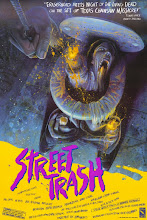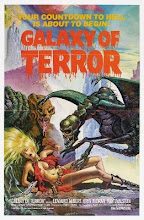Discerning gorehounds should require no introduction to Nacho Cerda, or his half hour mini-masterpiece Aftermath. The infamous little film was once considered to be somewhat of a holy grail for connoisseurs of grue, a bona fide underground phenomenon to be sought out and experienced on bootleg VHS. That was until a few years ago, when risk-taking DVD company Unearthed Films bequeathed it to the masses on a feature packed disc that collects the film with its two sibling works - The Awakening and Genesis.
To paraphrase something I wrote last year, I think Aftermath dwells in the same rarefied cinematic netherworld as Hideshi Hino's two Guinea Pig entries - Flowers of Flesh and Blood and Mermaid in a Manhole (both also available on DVD from Unearthed). It's a shadowy limbo where art and extreme gore coexist, comfortably and without a hint of pretension, irony or "artistic slumming".
Of course I'm not saying that horror cinema and "highbrow" art are mutually exclusive. One needs only peruse the works of Ken Russell, David Lynch, Kei Fujiwara, Lars von Trier, Shinya Tsukamoto, David Cronenberg, Jörg Buttgereit and many others to see that, if anything, the opposite is true. My point is that Aftermath and Hino's Guinea Pig films belong to a very small subset of films that seem to draw their inspiration from the least accessible reaches of each sphere - extreme gore (eg non-narrative, faux-snuff) and performance art.
What might appear to be an unlikely marriage at first glance suddenly makes more sense when you consider the shock tactics employed by some of the more extreme performance artists of the 60's, 70's and 80's. Take for example the excesses of the Viennese Aktionismus collective - the ritualistic disembowelment of animals favoured by Hermann Nitsch or the simulated penile dismemberment of Rudolf Schwarzkogler. There are undeniable commonalities shared by the extremes of horror and art: unfettered imagination; a desire to push cultural boundaries and explore taboos; a distaste for the banal, the mainstream and the commercial.
Cerda's Aftermath certainly ticks all these boxes - it's highly imaginative, taboo smashing and about as non-commercial as you can get. Not to say that Cerda didn't have commercial ambitions for Aftermath, indeed he originally conceived of it as a show reel to sell his talents as a director(!). However, unlike many show reels, this film isn't a shallow, technical exercise but a deeply personal project in it's own right. Amongst the gruesome proceedings, one can clearly see evidence of Cerda's fascination with Catholic iconography. It seems to me that the mortician here is a priest, garbed in his sacred vestments, and going through the motions of his familiar ritual. The morgue is his chapel... the autopsy table his altar. But all is not well in this death church, for the sense of elitist power that comes with the responsibility of presiding over the dead has overwhelmed the priest, festering into corruption and perversion.
The mortician's eyes, above his surgical mask, reveal a great deal of the turmoil that rages within. Self loathing, desire, pain, cunning, addiction, shame, and an exhaustion that will never be cured by sleep. His carnal desires have consumed him to the point that he has become an automaton, and although those eyes reveal much, they are also the dead eyes of a reptile. As dead as the corpses upon which the mortician works... and preys. Indeed the highly realistic cadavers laid out on the morgue's tables appear to have more life than he.
Speaking of convincing realism, Cerda did extensive research for Aftermath, interviewing a forensic surgeon and even attending a triple autopsy. The film was shot in a real, functioning morgue in Barcelona, and the corpses seen therein are a combination of exceptional prosthetic work and one amazing performance by a live actor. The outcome of all this research and attention to detail is a very unsettling vérité experience indeed. The late Chas. Balun even claimed that Nacho had gone too far, when he famously labeled the film as pornographic.
Add to the above attributes some beautiful cinematography, graceful editing and powerful sound design, and you've got yourself a pretty special little slice of sickness. Buy the DVD directly from Unearthed Films HERE. Beware the Necrophiliac Mortician...

To paraphrase something I wrote last year, I think Aftermath dwells in the same rarefied cinematic netherworld as Hideshi Hino's two Guinea Pig entries - Flowers of Flesh and Blood and Mermaid in a Manhole (both also available on DVD from Unearthed). It's a shadowy limbo where art and extreme gore coexist, comfortably and without a hint of pretension, irony or "artistic slumming".
Of course I'm not saying that horror cinema and "highbrow" art are mutually exclusive. One needs only peruse the works of Ken Russell, David Lynch, Kei Fujiwara, Lars von Trier, Shinya Tsukamoto, David Cronenberg, Jörg Buttgereit and many others to see that, if anything, the opposite is true. My point is that Aftermath and Hino's Guinea Pig films belong to a very small subset of films that seem to draw their inspiration from the least accessible reaches of each sphere - extreme gore (eg non-narrative, faux-snuff) and performance art.
What might appear to be an unlikely marriage at first glance suddenly makes more sense when you consider the shock tactics employed by some of the more extreme performance artists of the 60's, 70's and 80's. Take for example the excesses of the Viennese Aktionismus collective - the ritualistic disembowelment of animals favoured by Hermann Nitsch or the simulated penile dismemberment of Rudolf Schwarzkogler. There are undeniable commonalities shared by the extremes of horror and art: unfettered imagination; a desire to push cultural boundaries and explore taboos; a distaste for the banal, the mainstream and the commercial.
Cerda's Aftermath certainly ticks all these boxes - it's highly imaginative, taboo smashing and about as non-commercial as you can get. Not to say that Cerda didn't have commercial ambitions for Aftermath, indeed he originally conceived of it as a show reel to sell his talents as a director(!). However, unlike many show reels, this film isn't a shallow, technical exercise but a deeply personal project in it's own right. Amongst the gruesome proceedings, one can clearly see evidence of Cerda's fascination with Catholic iconography. It seems to me that the mortician here is a priest, garbed in his sacred vestments, and going through the motions of his familiar ritual. The morgue is his chapel... the autopsy table his altar. But all is not well in this death church, for the sense of elitist power that comes with the responsibility of presiding over the dead has overwhelmed the priest, festering into corruption and perversion.
The mortician's eyes, above his surgical mask, reveal a great deal of the turmoil that rages within. Self loathing, desire, pain, cunning, addiction, shame, and an exhaustion that will never be cured by sleep. His carnal desires have consumed him to the point that he has become an automaton, and although those eyes reveal much, they are also the dead eyes of a reptile. As dead as the corpses upon which the mortician works... and preys. Indeed the highly realistic cadavers laid out on the morgue's tables appear to have more life than he.
Speaking of convincing realism, Cerda did extensive research for Aftermath, interviewing a forensic surgeon and even attending a triple autopsy. The film was shot in a real, functioning morgue in Barcelona, and the corpses seen therein are a combination of exceptional prosthetic work and one amazing performance by a live actor. The outcome of all this research and attention to detail is a very unsettling vérité experience indeed. The late Chas. Balun even claimed that Nacho had gone too far, when he famously labeled the film as pornographic.
Add to the above attributes some beautiful cinematography, graceful editing and powerful sound design, and you've got yourself a pretty special little slice of sickness. Buy the DVD directly from Unearthed Films HERE. Beware the Necrophiliac Mortician...















_poster.jpg)



































































Tremendous post Aylmer, really fascinating reading... I was only listening to Hermann Nitsch's drone epic Harmoniumwerk a few days ago. I never got around to grabbing a copy of Aftermath and I think it's OOP now... I'll check the Unearthed site when I get home from work later. Anyway, I'll get to see this, thanks for the upload...
ReplyDeleteNo worries Wes, enjoy!
ReplyDeleteFantastic write up! My curiosity can't take anymore; I'm going to check out Aftermath this evening on the basis of this post. I'm currently researching boundaries between pornography, violence and cinema - so this should be an interesting work to view. Cheers for sharing. :)
ReplyDeleteExcellent analysis of a truly fascinating and revolting film. I had heard about Aftermath years ago, but didn't get to see it until the Unearthed DVD was released (I even got the limited gore cover). Your points about the Catholic iconography are very interesting. I'll have to revisit Aftermath with this idea in mind.
ReplyDeleteI watched this last night, on (unbelieveably) Netflix! Went even beyond what I was expecting after reading your post. First film to make me feel queasy probably since I was a child! Thanks for the tip!
ReplyDeleteAftermath: unsettling,curious.
ReplyDeleteI gotta say I turned my head away while the dude was jerking off.
Early Cannibal corpse + Nacho Cerda = winning combination for a music video!